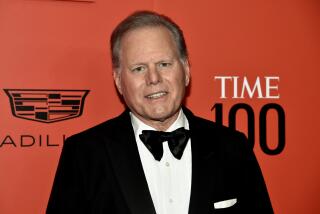Column: Marissa Mayer’s $23-million severance from Yahoo may look obscene. But it’s even worse.

Verizon Communications Inc. is in the process of buying Yahoo’s digital services. (March 13, 2017)
- Share via
On the surface, if there’s something positive to be said for the $23-million golden parachute due to Yahoo CEO Marissa Mayer as the company gets sold to Verizon, it’s that the payoff isn’t $55 million, the sum that was disclosed in a corporate filing last July, or even $44 million, the sum estimated in a filing last September.
But looks can be deceiving. One reason Mayer’s severance package appears to have shrunk is that the company’s latest disclosure leaves off tens of millions of dollars in stock options held by Mayer as of March 8, but already vested. So they aren’t subject to the accelerated vesting of $20 million in stock incentives that would result from the sale and Mayer’s departure from the company. That acceleration would provide the bulk of her severance.
But as some $56.8 million in options evidently have vested since the Verizon deal was announced in July, it’s reasonable to add them to the invoice. That puts Mayer’s out-the-door price nearer to $80 million.
Failures in communication, management, inquiry and internal reporting contributed to the... 2014 security incident.
— Yahoo board blames Mayer’s team for an enormous data breach
Part of that sum is included in the roughly $140 million in cash, stock and option compensation she has been awarded since her appointment as Yahoo’s chief executive in July 2012. The critical question about Mayer’s more than four-year reign is whether she was worth the money. The answer is almost certainly no, which raises in turn a second question — why did the Yahoo board reward her so lavishly? — and a third: Do America’s boards have any ability to distinguish good performance from bad, and pay their executives accordingly?
Mayer faced a difficult task when she joined Yahoo. The company was rudderless, having gone through four CEOs in the previous five years. It had lost the capacity to define its own mission — was it in the Internet search business? The entertainment business? Or was it just a platform for Web-based advertising?
Mayer, then 37, looked like the glamorous answer to Yahoo’s ills. She held a top engineering job at Google and came with the image of a can-do Silicon Valley woman juggling motherhood and a demanding job. But doubts weren’t long in surfacing. These were inspired by her difficulties managing colleagues and subordinates and her tendency to make splashy, but expensive, strategic moves such as hiring Katie Couric as Yahoo’s “global news anchor” for $6 million a year (later raised to a reported $10 million).
Mayer seemed preoccupied with trivialities. In 2013 she masterminded a redesign of the Yahoo! logo, an enormous waste of time and resources of which she was inordinately proud. (“Our last move was to tilt the exclamation point by 9 degrees, just to add a bit of whimsy.”) The idea was to refresh Yahoo’s brand, but the effort was bass-ackwards. As one branding expert explained, “Branding doesn’t start with the logo….It is who you are, not how you look.”
Meanwhile, Mayer and her management team were failing to keep their eyes on the ball. While they were redesigning the logo, it appeared Russian hackers were invading its network and stealing the personal information of more than a billion Yahoo users; another attack in 2014 struck 500 million accounts. Mayer claimed she didn’t learn of the attacks until September 2016, which is inexcusable.
The Yahoo board canceled Mayer’s 2016 bonus and allowed her to forego her 2017 equity award after finding that it was left in the dark about the breaches and that “failures in communication, management, inquiry and internal reporting contributed” to the 2014 episode. The two breaches cost Yahoo shareholders dearly, as they resulted in a $350-million reduction in the price Verizon will pay for Yahoo’s Internet assets, cutting the deal to $4.48 billion.
Mayer’s regime, as we wrote in 2015, was “a peculiar combination of buzzy dynamism and nebulous strategy.” She spent $2 billion to acquire 53 Internet businesses for her “MaVeNS” strategy, an acronym for “mobile, video, native advertising, and social.” These acquisitions were haphazard, generally mishandled. The value of Tumblr, a social media site, which was to be the centerpiece of the strategy, was written down in 2015 by $230 million, part of a staggering goodwill impairment charge of $4.5 billion that year, reflecting overpayment for virtually the entire portfolio.
By 2016, Yahoo stock was viewed chiefly as a proxy for the company’s holdings in the Chinese e-commerce giant Alibaba and Yahoo Japan, which predated Mayer’s appointment. As of the date of the company’s 2016 proxy statement, Yahoo valued its Alibaba stake at $29.4 billion and its 35.5% stake in Yahoo Japan at $8.7 billion. Yahoo’s market value that day was $34.7 billion. In other words, the stock market valued everything other than those two holdings — that is, everything subject to Mayer’s management — at a negative $3.4 billion.
Mayer’s future with what’s left of Yahoo remains unclear. When the Verizon deal was announced, she said she intended to stay on, but that’s unlikely. As a result, the actual terms of her severance are up in the air. It’s a double-trigger arrangement, which means it kicks in if there’s both a change in control, as would happen with the Verizon acquisition, and Mayer’s departure.
It’s only fair to repeat that Yahoo may have been beyond saving when Mayer took the helm. So it’s not proper to say that she ran it into the ground, as some critics assert; it’s only fair to say that she didn’t do much, if anything, to extend its glide path to extinction. Keeping a high-flying company aloft through multiple changes in technology, economics and social habits is a herculean challenge that has been met by precious few CEOs in history. It’s instructive to observe that of the 12 industrial companies in the original 1896 Dow Jones Industrial Average, only one still remains in the index: General Electric. Most of the others, and dozens that joined at one point or another, have been lost to the buffetting of history.
Yet that returns us to the question of what Mayer was getting paid for. Her compensation peaked in 2014 at $42 million. That year the company reported a profit of $7.5 billion on revenue of $15 billion — but $10.4 billion of that revenue came from the sales of Alibaba shares, which hardly can be chalked up to her management. The following year, when the Alibaba gain had gone away, Yahoo lost $4.4 billion on revenue of $5 billion. (That was the year of the big writedown.) Yet Mayer still collected a cool $36 million in pay.
Perhaps the Yahoo board thought she was still able to turn things around, and wanted to keep her from being discouraged. If so, those were some very expensive pats on the back.
Keep up to date with Michael Hiltzik. Follow @hiltzikm on Twitter, see his Facebook page, or email [email protected].
Return to Michael Hiltzik’s blog.
More to Read
Inside the business of entertainment
The Wide Shot brings you news, analysis and insights on everything from streaming wars to production — and what it all means for the future.
You may occasionally receive promotional content from the Los Angeles Times.











